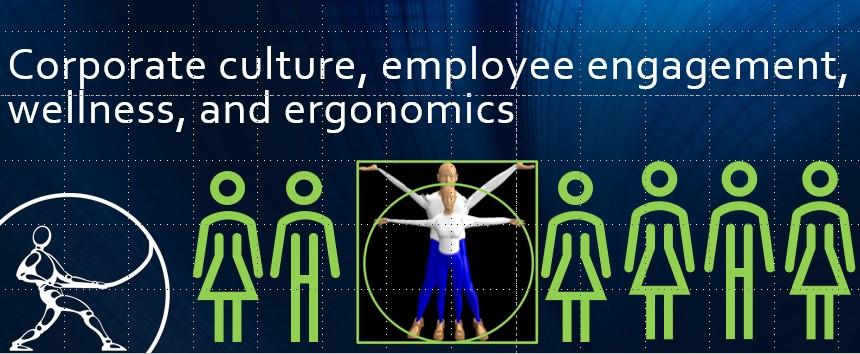I’ve been hearing a lot about corporate culture, employee engagement, and wellness lately. And I wonder why ergonomics isn’t included in that buzz.
Corporate culture refers to the basic assumptions that workers acquire over time about how their employer deals with internal and external problems. It affects how people interact, what resistance they face during change, and how they share (or do not share) information. Employees would be loyal to an organization with a positive culture, and would function well there because they feel heard, and their teams act cohesively and communicate openly. In the past year, turnover has become a costly challenge for many companies; an organization with good culture can expect that employees will want to stay longer.
Employee engagement refers to the attitude of a worker towards the employer and its values. An engaged employee has a positive attitude toward the organization; an engaged employee might outperform a co-worker with low engagement. Many factors drive engagement, including how important the employee feels in the organization, the quality of working relationships with supervisors and peers, opportunities for advancement, and more. Consider a company where the corporate goals, posted for all to see, focus exclusively on the relationships with customers. What message does that send to employees? It’s perhaps even less appealing to say one thing and do another. How many organizations who assert “respect for every employee’s potential and job satisfaction” would hear these values echoed in the lunchroom?
Workplace wellness refers to health promotion activities or policies that support healthy behaviour and improve health outcomes. These activities often include education, medical screening, weight management programs, and fitness programs or facilities.
Ergonomics ought to be an integral part of optimizing employee culture, generating engagement, and promoting wellness. The bottom line is, “If I feel comfortable in my work, I will be able to perform to my best ability, and I will go home satisfied at the end of the day.”
Perhaps the concept is more easily understood in reverse. When ergonomics is not integrated into the workplace, employee wellness, culture, and engagement suffer. Do any of these statements sound like something you might hear in your lunchroom?
“When my back aches, I spend a lot of time shifting around, trying to get comfortable. My mind is not really on my work, and I’m just counting minutes until I can go home.”
“I know that I am supposed to inspect the far side of the part, and I try to, but by 10 o’clock, my neck is hurting, so I start letting the odd part go by to give myself a break. Sometimes I lift the part up to take a look. By the end of the shift, I’m ashamed to admit that I’m definitely not checking every part.”
“My supervisor doesn’t really care if I stay at my workstation right until break, so I usually try to work ahead so I can leave for break a bit early. I really need that extra time to rest! The next worker on the line says she doesn’t really mind pulling my parts down from the stack.”
“Yes, I’ve called in sick when my arms ache too much. I don’t want to make a fuss about my job; I think I’m the only one who has a problem, and that’s probably just because I’m short.”
“Ergonomics” means fitting the work to the worker. In manufacturing environments, when people think about ergonomics, they are usually thinking about strain/sprain injuries, or “musculoskeletal disorders” (MSDs). Most companies have more MSDs than any other type of injury. But if a specific job or task has not been associated with MSDs, companies may struggle to justify making a change.
News flash! Ergonomics problems show up in other ways, BEFORE they become injuries. When work doesn’t fit workers, they produce poor quality work, they can’t keep up, and they disengage from the workplace. They also take these issues home; when workers are fatigued or sore at the end of the day, they are less likely to put energy into healthy behaviours like exercising, getting outside, or cooking a healthy meal.
The culture, engagement, and wellness spin-off effects of poor ergonomics might be even more costly than the compensation costs associated with MSDs. So even if your organization is one of the few that does not have high MSD rates, ergonomics might offer the opportunity to improve quality, productivity, or job satisfaction.
These are the questions we’re aiming to tackle with a research project this summer. If you have made an ergonomics recommendation but you’re struggling to get approval for the funds, consider becoming one of our research partners. We intend to partner with several organizations to develop a cost-justification protocol that does not rely on injury history. Contact Carrie@TaylordErgo.com for more info.


